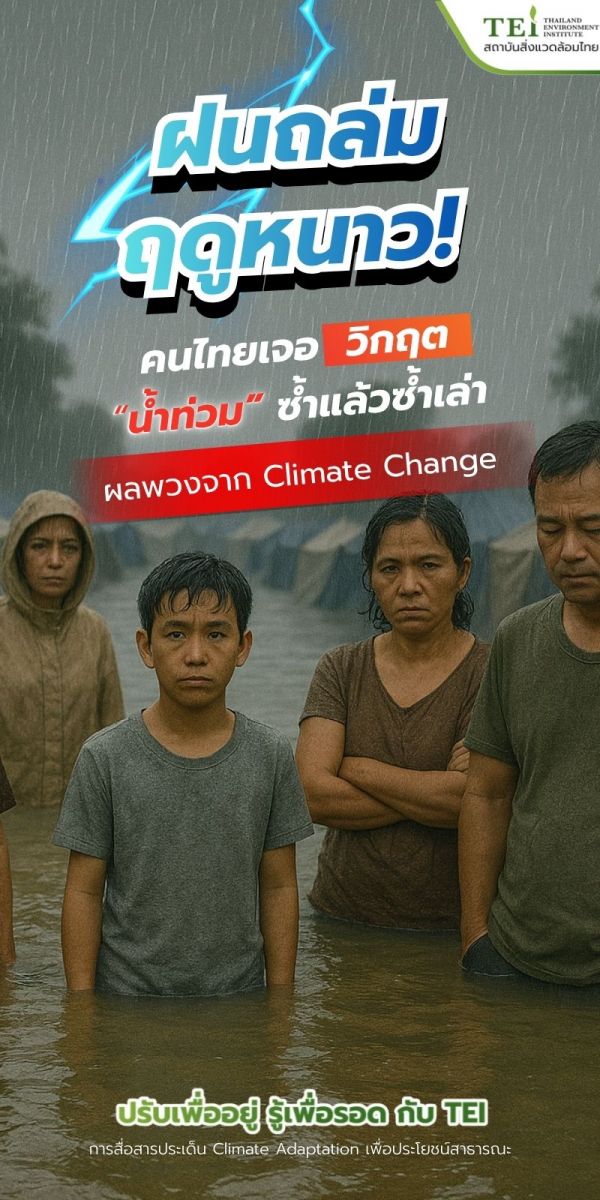
Thematic Areas: Climate Adaptation
Welcoming the opening of the second semester of the 2025 academic year for students across Thailand, we are faced with heavy rains and flash floods in many areas. These events have occurred rapidly and severely, leading to a storm of social media posts asking the question: "Heavy winter rains, unseasonal flash floods—what is happening to Thailand's weather right now?"

Regarding the events during this period, data from the Meteorological Department indicates that from the late night of November 2, 2025, to the morning of November 3, 2025, many areas experienced an average rainfall of more than 200 millimeters per hour. This is significantly higher than the normal average and overwhelmed drainage capabilities. Many areas have a drainage potential of no more than 50 millimeters per hour, resulting in rapid flooding. This was particularly severe in Bangkok and its vicinity, heavily impacting Khlong Luang District, Pathum Thani Province (a dense residential area), and provincial areas like the foothills in Chiang Mai Province, where flash floods followed.
The volatile weather is a result of Climate Change, forcing Thailand and the rest of the world to face "off-the-textbook" seasons. What Thailand is currently facing—heavy winter rains leading to unseasonal flash floods—confirms this.
The Thailand Environment Institute (TEI) states that Thailand urgently needs to study trends and the potential formation of monsoon troughs and storms that cause these heavy winter rains. Statistically, on average, Thailand usually encounters only 3-4 influential storms per year.
While the average number of storms moving directly into Thailand is 3-4 per year, in 2025 (as of Nov 5), we found that Thailand has suffered indirect impacts from storms forming in the region (e.g., the South China Sea) multiple times. TEI points out that these phenomena—where storms influence heavy winter rains and unseasonal floods without a direct hit—stem from climate change.
The direct impact on Thais includes urban flooding affecting commuting, damage to engines (both combustion and electric vehicles), traffic congestion, and the need for citizens to wade through water, which poses accident risks. These recent events reflect that Thailand's preparation for Climate Adaptation is still insufficient.
TEI is committed to communicating the importance of Climate Adaptation for the public good, ensuring Thais are prepared under the concept "Adapt to Live, Know to Survive." The goal is to elevate the quality of life and safety regarding Climate Change through the following levels:
Individual LevelMonitor Weather: Closely follow forecasts and disaster warnings from reliable sources.
Check Your Home: Ensure the house is structurally sound. Clean gutters and drains to prevent clogging. Prepare sandbags or flood barriers if you are in a risk area.
Emergency Prep: Prepare an "Emergency Survival Bag" and move valuables and electrical appliances to higher ground upon receiving a warning.
Plan Travel: Check routes before leaving. Avoid flooded paths and do not drive through high floodwaters.
Risk Maps: Create community Risk Maps to identify flood-prone areas.
Early Warning: Establish an internal community early warning communication system.
Infrastructure: Maintain infrastructure by regularly dredging canals and drainage channels.
Sponge City: Develop a "Sponge City" by increasing green spaces, parks, and small water retention areas (Monkey Cheeks) to slow down and absorb water.
Urban Planning: Design city plans with Flood Plains in mind. Avoid authorizing construction that blocks waterways.
Shelters: Prepare safe zones or temporary shelters within the community and conduct regular evacuation drills.

TEI invites all Thais to adjust and change to create a society safe from unseasonal rains, following the path of "Adapt to Live, Know to Survive."

Share: